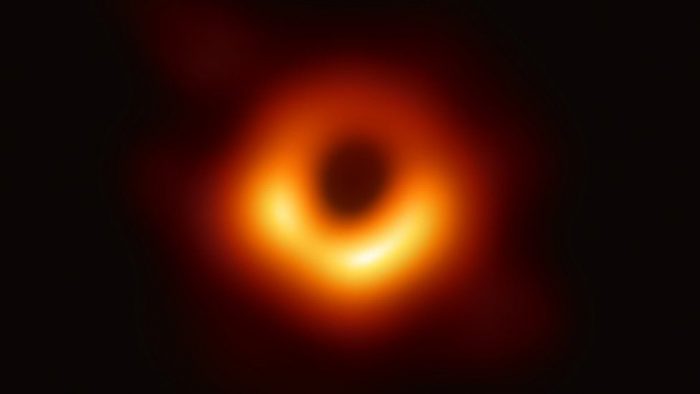Well everybody, we finally did it. Humanity took a picture of a black hole.
Yesterday morning, astronomers revealed the photo that you see at the top of this post. An image of a supermassive black hole that is found at the centre of the galaxy M87.
In a historic feat by @EHTelescope & @NSF, a black hole image has been captured for the 1st time. Several of our missions observed the same black hole using different light wavelengths and collected data to understand the black hole's environment. Details: https://t.co/WOjLdY76ve pic.twitter.com/4PhH1bfHxc
— NASA (@NASA) April 10, 2019
First off, a few numbers.
This galaxy is 55 million light years away. The black hole at its centre has a mass (or amount of matter) that is 6.5 billion times the mass of our Sun. And the width of the dark circle? It's about 40 billion kilometres across. You could easily fit the orbits of the planets of our solar system inside it.
The incredible density of the black hole creates a force of gravity that is so strong that not even light can escape it once it gets too close. That is why black holes are dark—the circle that you see in the image is at that "too close" point, a.k.a. the event horizon.
So it's huge, dense, super far away, and dark. Sounds pretty cool, but ... didn't we already know all of this about black holes? Why is everyone so excited?
Finally, we have visual proof
Until yesterday's announcement, every single image you've ever seen of a black hole—including this stunner—has been artwork. (Getty Embed)
Really, it comes down to this—this image finally gives us visual proof of the existence of black holes. Even though most of us have lived with the idea of black holes our whole lives, our belief in them has been based on two types of observations.
First were the theories. Using math, theorists like Albert Einstein and Stephen Hawking predicted that black holes should exist.
Second were the effects that black holes had on objects around them. Over and over, astronomers would see huge stars orbiting around an area of space that looked completely empty. Whatever was there had to be incredibly dense and dark. Like the black holes Einstein imagined.
In other words, both the theories and these effects only suggest that (and where) black holes would exist. But it could've been something else entirely. Until now, the observations were kind of like tracks in the snow and an empty garbage can. It sure looks like a raccoon ate your leftovers. But you still don't have a picture of the elusive creature. So how do you know for sure?
How did they do it?
So how did scientist finally get a shot of this interstellar bandit? (Keep in mind that the raccoon in question lives on the other side of the universe, too.)
It required eight telescopes around the world (known together as the Event Horizon Telescope), all looking together at the same patch of space for a week straight. It took tons of good luck because we needed mostly clear skies over that time. And it took collecting and sorting through tons of data (as the tweet below shows).
Left: MIT computer scientist Katie Bouman w/stacks of hard drives of black hole image data.
Right: MIT computer scientist Margaret Hamilton w/the code she wrote that helped put a man on the moon.
(image credit @floragraham)#EHTblackhole #BlackHoleDay #BlackHole pic.twitter.com/Iv5PIc8IYd
— MIT CSAIL (@MIT_CSAIL) April 10, 2019
But in the end? It gave us a chance to see the unseeable. Incredible!
 This black hole is at the centre of the galaxy M87. The dark circle in the middle is as wide as our entire solar system! (EHT/NASA/ESA)
This black hole is at the centre of the galaxy M87. The dark circle in the middle is as wide as our entire solar system! (EHT/NASA/ESA)










Wow! I guess I had never really thought about how there were no real pictures of black holes! I spent almost 10 minutes studying this picture to try to understand what was going on.. So cool!
I watched it live!!!! It was so cool!!! 😀 😀
That is incredible !
😀 Wow. Just wow. I can’t believe that we (Finally) have visual proof of black holes! It’s incredible, if you think about it. Not even 100 years ago, we were still struggling to make it to space. I CANNOT BELIEVE IT. Great job NASA!